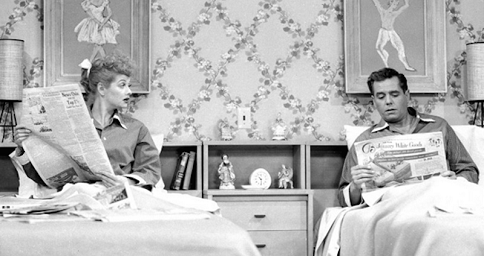Separate Beds – Were the Ricardos Onto Something?
First things first.
If you don’t know who the Ricardos are…. well, how sad. And also, I feel old.
Ricky and Lucy Ricardo – aka Desi Arnaz and Lucille Ball – were the zany 1950s TV sitcom couple starring in I Love Lucy. Many of us of a certain age grew up watching these black and white reruns that are, sadly, becoming harder to find on TV.
Despite Lucy driving Ricky crazy with her nutty plans to find her way into show biz, and Ricky frustrating those plans at every turn, they otherwise seemed to be a normal married couple who genuinely loved each other. So why the separate beds?

“The Code”
They weren’t alone. Early TV programs either didn’t show married couples’ bedrooms at all, only gave the briefest glimpses through a half open door, like Ward and June Cleaver on Leave It To Beaver…once, or were gutsy enough to have bedroom scenes – but only if they had separate, twin beds, like Ricky and Lucy, or Rob and Laura Petrie on The Dick Van Dyke Show.
These couples’ bedroom choices stemmed directly from Hollywood’s Motion Picture Production Code, in effect from the early 1930s until the late 1960s. Couples were not to be seen lying horizontally in a bed together. Many movies and television shows felt it safer altogether not to even hint that a couple might sleep together in one bed (gasp), and chose to portray them with two twin beds, separated by a few feet and usually a nightstand or table for good measure.
It’s unclear whether this cleansed the lascivious thoughts of movie-goers and TV-watchers, or just pointed out the obvious thought, “Yeah, but what do they do when they want to….er…. you know!”
Real couples sleep separately?
So, the separate beds thing was just for old black and white TV and movies then, right?
Not so fast. In 2005 the National Sleep Foundation conducted a survey on sleeping habits entitled “2005 Sleeping in America Poll (PDF)” and based on their results concluded that about a quarter (26%) of Americans lose some sleep because of their partner having sleep problems or disorders.
According to the report, about 23% said they sleep in a separate bed, bedroom or on the couch to ensure that both of them can sleep well.
In newer research, National Sleep Foundation published their “2013 International Bedroom Poll (PDF).” In addition to the United States they surveyed people in Canada, Germany, Japan, Mexico and the United Kingdom, with respondents between the ages of 25 and 55.
In this survey, respondents were asked who they “slept with on most nights” in the past two weeks. Of those who were married or living with someone, only 82% in the United States said they slept with their significant other.
That means 18% of partnered Americans between ages 25 and 55 are not regularly sleeping with their partners.
In Mexico it was 79%, and in Japan only 63%! Canadians reported 85%, Germans 87%, and finally, United Kingdom reported 89%.
Those are some pretty surprising numbers – at least they were for me. I wanted to know more, so I dug into the numbers a bit. The 2005 survey doesn’t tell us whether these couples were sleeping separately every night, twice a week, a couple of times a month, or occasionally. The 2013 survey asked “on most nights” so that’s a more definitive indication that plenty of couples are choosing separate sleeping arrangements more than just occasionally, and were willing to say so.
A New York Times article from 2007 noted that some home builders were seeing about a quarter of their custom home clients requesting their new homes include two master bedrooms. And just last year (2017), a Realtor.com article noted that in the $2 million plus market, nearly a third of prospective home buyers were interested in the option of two master bedrooms.
Some home buyers that gravitate towards multiple masters may be interested in having a master guest room or suite to offer visiting family and friends. Some may be multi-generational households where two masters would be helpful. But it’s fair to assume that a chunk of these people are couples who want to sleep in separate bedrooms. At least some of the time.
No matter the actual numbers, it’s pretty clear that sleeping separately isn’t the rare occurrence I assumed it was. In fact, the practice has become known as a “sleep divorce,” a term which seems to have become commonly used in around 2013.
In years past, we might have assumed that anyone sleeping separately was either older and not interested in sex anymore, or in a stale marriage and no longer sexually interested in each other. We’re much more enlightened these days, and those stereotypes don’t hold up. The truth is that most couples who choose to sleep apart report being happy and fulfilled in their relationships.
They just find they sleep better apart. Why is that?
In the 2005 National Sleep Foundation survey mentioned earlier, the single most common factor given for having sleep disrupted by a partner is….drumroll….snoring. Anticlimax, right? No big surprise there. Runners up are twitching or moving around in bed excessively, and last, pauses in breathing as in sleep apnea.
Behind Closed Doors
Different preferences can mean one or the other partner is having to make compromises, which in turn causes their best sleep to be compromised. Things like room temperature, whether the windows are open or closed or the bedclothes are tucked or not tucked can seem small, but cause real frustrations at bedtime.
Partners having different work, and thus sleep schedules is also a common reason cited. It’s no fun having the alarm go off at 4:00 am if you don’t have to get up until 7:00, or having your partner plop themselves into bed at 2:00 am and waking you out of a deep sleep.
One partner being in some kind of physical discomfort or unease can also cause couples to sleep apart some or all of the time. Pregnancy is one example, where there are multiple bathroom visits in the night and difficulty getting comfortable. Or an illness or chronic pain suffered by one partner may cause them to sleep very lightly and be easily disturbed. The well partner may also be kept awake by the other’s inability to sleep well.

It seems that the choice to sleep separately is less about actually wanting to be apart, and more about both partners being able to get the best sleep they possibly can. And, that it doesn’t seem to be about, or cause, diminished emotional or physical intimacy.
As one woman interviewed in the New York Times article about her separate-sleeping preferences expressed, “It’s more exciting when you can say, ‘Your room or mine?’ ”

0 Comments on “Separate Beds – Were the Ricardos Onto Something?”